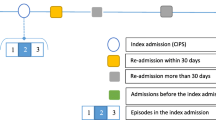Abstract
Purpose
Integral to maintaining good outcomes post-endovascular aneurysm repair (EVAR) is a robust surveillance protocol. A significant proportion of patients fail to comply with surveillance, exposing themselves to complications. We examine EVAR surveillance in Wessex (UK), exploring factors that may predict poor compliance.
Methods
Retrospective analysis of 179 consecutive elective EVAR cases [2008–2013] was performed. 167 patients were male, with the age range of 50–95. Surveillance was conducted centrally (tertiary referral trauma centre) and at four spoke units. Surveillance compliance and predictors of non-compliance including age, gender, co-morbid status, residential location and socioeconomic status were analysed for univariate significance.
Results
Fifty patients (27.9 %) were non-compliant with surveillance; 14 (8.1 %) had no imaging post-EVAR. At 1 year, 56.1 % (of 123 patients) were compliant. At years 2 and 3, 41.5 and 41.2 % (of 65 and 34 patients, respectively) were compliant. Four years post-EVAR, only one of eight attended surveillance (12.5 %). There were no statistically significant differences in age (p = 0.77), co-morbid status or gender (p = 0.64). Distance to central unit (p = 0.67) and surveillance site (p = 0.56) was non-significant. While there was a trend towards compliance in upper-middle-class socioeconomic groups (ABC1 vs. C1C2D), correlating with >50 % of non-compliant patients living within <10 mile radius of the central unit, overall predictive value was not significant (p = 0.82).
Conclusions
Compliance with surveillance post-EVAR is poor. No independent predictor of non-compliance has been confirmed, but socioeconomic status appears to be relevant. There is a worrying drop-off in attendance beyond the first year. This study highlights a problem that needs to be addressed urgently, if we are to maintain good outcomes post-EVAR.





Similar content being viewed by others
References
Jones WB, Taylor SM, Kalbaugh CA et al (2007) Lost to follow-up: a potential under-appreciated limitation of endovascular aneurysm repair. J Vasc Surg 46(3):434–440
Van der Vliet JA, Kool LJ, Van Hoek F (2011) Simplifying post-EVAR surveillance. Eur J Endovasc Surg 42(2):193–194
Mor M, Niv G, Niv Y (2006) Patient retention in a clinical trial: a lesson from the rofecoxib (VIOXX) study. Dig Dis Sci 51(7):1175–1178
Elkouri S, Gloviczki P, McKusick MA et al (2004) Perioperative complications and early outcome after endovascular and open surgical repair of abdominal aortic aneurysms. J Vasc Surg 39(3):497–505
Harris PL, Vallabhaneni SR, Desgranges P et al (2000) Incidence and risk factors of late rupture, conversion and death after endovascular repair of infrarenal aortic aneurysms: the EUROSTAR experience. European Collaborators on stent/graft techniques for aortic aneurysm repair. J Vasc Surg 32(4):739–749
Lifeline Registry of EVAR Publications Committee (2005) Lifeline registry of endovascular aneurysm repair: long-term primary outcome measures. J Vasc Surg 42(1):1–10
Sarangarm D, Knepper J, Marek J et al (2010) Post-endovascular aneurysm repair patient outcomes and follow-up are not adversely impacted by long travel distance to tertiary vascular surgery centers. Ann Vasc Surg 24(8):1075–1081
Kret MR, Azarbal AF, Mitchell EL et al (2013) Compliance with long-term surveillance recommendations following endovascular aneurysm repair or type B aortic dissection. J Vasc Surg 58(1):25–31
Nordon IM, Karthikesalingam A, Hinchliffe RJ et al (2010) Secondary interventions following endovascular aneurysm repair (EVAR) and the enduring value of graft surveillance. Eur J Vasc Endovasc Surg 39(5):547–554
Karthikesalingam A, Page AA, Pettengell C et al (2011) Heterogeneity in surveillance after endovascular aneurysm repair in the UK. Eur J Vasc Endovasc Surg 42(5):585–590
Holt PJ, Poloniecki JD, Khalid U et al (2009) Effect of endovascular aneurysm repair on the volume-outcome relationship in aneurysm repair. Circ Cardiovasc Qual Outcomes 2(6):624–632
Zhou W, Blay E Jr, Varu V et al (2014) Outcome and clinical significance of delayed endoleaks after endovascular aneurysm repair. J Vasc Surg 59(4):915–920
Garg T, Baker LC, Mell MW (2015) Adherence to postoperative surveillance guidelines after endovascular aortic aneurysm repair among Medicare beneficiaries. J Vasc Surg 61(1):23–27
Kirkpatrick VE, Wilson SE, Williams RA, Gordon IL (2014) Surveillance computed tomographic arteriogram (CTA) does not change management before three years in patients who have a normal post-EVAR study. Ann Vasc Surg 28(4):831–836
Toya N, Kanaoka Y, Ohki T (2014) Secondary interventions following endovascular repair of abdominal aortic aneurysm. Gen Thorac Cardiovasc Surg 62(2):87–94
Acknowledgements
Dr AHM Morbi was supported by the University of Southampton National Institute of Health Research Academic Foundation Programme. The authors acknowledge the support of the Vascular Surgery and Vascular Interventional Radiology Departments, University Hospital Southampton NHS Foundation Trust.
Conflict of interest
All authors declare that they have no conflicts of interest to disclose.
Ethical Approval
Retrospective study: For this type of study, formal consent is not required.
Author information
Authors and Affiliations
Corresponding author
Rights and permissions
About this article
Cite this article
Godfrey, A.D., Morbi, A.H.M. & Nordon, I.M. Patient Compliance with Surveillance Following Elective Endovascular Aneurysm Repair. Cardiovasc Intervent Radiol 38, 1130–1136 (2015). https://doi.org/10.1007/s00270-015-1073-8
Received:
Accepted:
Published:
Issue Date:
DOI: https://doi.org/10.1007/s00270-015-1073-8




